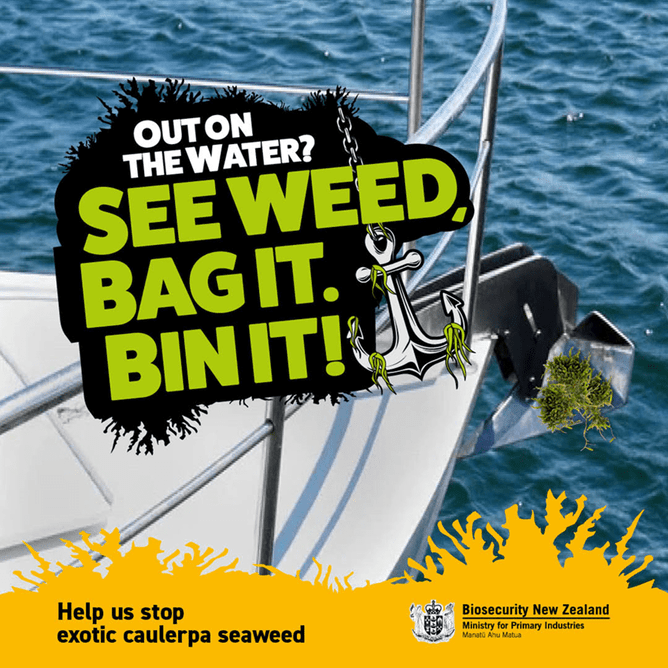Funding boost for caulerpa fight
The exotic caulerpa work programme has just received a $5 million boost from the Government to fast-track the development of removal methods and understand more about this fast-spreading pest.
The funding is primarily an investment in technology to stop caulerpa where it is and then, potentially, eliminate it from affected areas.
The key project to benefit from the additional funding is the large-scale suction dredge trial currently underway at Omākiwi Cove in the Bay of Islands where there is a significant infestation of caulerpa.
This trial is government-funded and led by Northland Regional Council in partnership with mana whenua. It features a large, remote-controlled suction head with rotating brushes mounted on a barge. See more on the technique below.
Read the announcement here.
Te Rāwhiti suction dredge trial
The suction dredge tool being trialled at Omakiwi Cove in the Bay of Islands is looking to be a promising solution for possible elimination of caulerpa in Te Rāwhiti.
The dredge features a large suction head with rotating brushes, operated remotely from a barge. Caulerpa is sucked up and disposed of on land. This allows bigger areas of caulerpa to be removed than the diver-controlled method that has been tested at Aotea Great Barrier Island.
Final results of the trial are expected in June 2024. We want to see this technology refined at pace and available to use in other affected areas.
Taking the message to communities
Boaties, fishers and divers need to know about caulerpa and what they need to do to avoid spreading it. Since the early days of the response, there has been a team of locally-employed, on-the-ground ‘ambassadors’ working at Aotea to communicate this important information.
Hannah Smith leads the ambassadors at Aotea Great Barrier Island and Kelly MacPherson leads the new team this summer, which includes her brother, at Ahuahu Great Mercury Island. Both talk about their work in the field.
Update from Kelly – ambassador Ahuahu Great Mercury Island
The team has had a busy and productive February delivering information materials and talking with local tour boat operators and people at the Whitianga Marina, Whitianga Wharf, boat ramps and carparks.
“We have refreshed campaign messaging and materials in businesses from Whangapoua through to Hotwater Beach and included many more businesses/shops,” Kelly says.
“On Monday 5 February (the day before Waitangi Day), we noticed a large number of boaties were out on the water, so we took the opportunity to stop at each boat ramp and placed a pamphlet on 420 car windows.
“My usual role is with the Department of Conservation, so it has been an advantage learning and undertaking biosecurity mahi from this perspective and building connections with the biosecurity lead on Ahuahu Great Mercury Island.
Kelly says the response from the public and business owners has been positive.
“It’s wonderful to see how many people are now aware of caulerpa being out there, and that many are willing to share this information with customers to spread the word. The more people that are aware, the better.
“We even had a lady call and ask for some pamphlets to go into the welcome packs for the women’s Okuma fishing competition that was held last week, with 150 registered anglers!”
Update from Hannah – ambassador Aotea Great Barrier Island
“It has been a real pleasure working with the Aotea ambassadors over the summer”, says Hannah.
“Each ambassador is passionate about the cause because they have felt the direct impact of exotic caulerpa spread around the motu, as well as having been affected by the ongoing Controlled Area Notices (CANs) - not just in terms of marine biodiversity and kai moana gathering but also the ongoing economic effects that the controlled anchoring areas are having on the community.
“Aotea is a hot spot for marine traffic all year round, with summer being a peak time for vessels travelling from Auckland and beyond.
“In terms of reducing spread, we have been fortunate that boat numbers have not reached extreme highs, but we have still had to approach more than 130 boats anchored in the ‘no anchoring’ area over the summer period.
“We are all thankful that the majority have stuck to the rules, and we hope that the work completed over the summer has had a positive impact on reducing the spread of caulerpa.
“Hopefully as a community, we can move onto a number of control techniques this autumn, and I am looking forward to the next stage beyond monitoring.”
Public education campaign continues
Our marketing campaign to educate water users about caulerpa, launched in late November 2023, continues to run on digital media and other places boaties and fishers visit.
The purpose of the campaign is to inform boaties, fishers and divers about the simple actions they need to take when at sea to avoid spreading caulerpa.
The campaign includes targeted digital, mainstream media, radio and social media advertisements. The campaign is also being extended to include signs in locations across the upper North Island - where boaties go and where exotic caulerpa could find a suitable habitat to establish.


